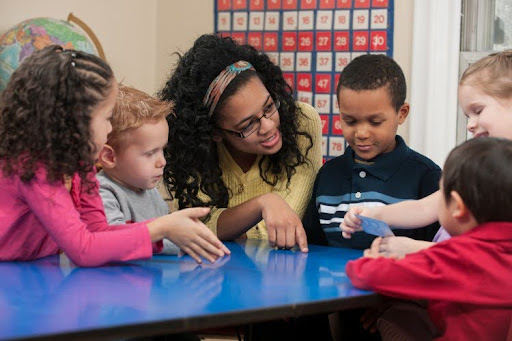Social and emotional learning (SEL) continues to grow in popularity. More than 75 percent of American schools used a social and emotional learning curriculum in 2022, according to research from RAND.
Exactly what is social and emotional learning, and why is social and emotional learning important? Research shows that SEL helps students academically, behaviorally and socially. Long-term studies demonstrate the positive impacts of SEL on student well-being, even 18 years later. Educators overwhelmingly agree that SEL instruction is critical in the classroom.
Experienced educators can foster social and emotional development in students of all ages. A master’s degree in education can help teachers strengthen their SEL instructional abilities.
What Is Social and Emotional Learning?
Social and emotional learning refers to how children develop social and emotional strengths. The broad spectrum of social and emotional skills includes stress management, responsible decision-making, goal setting and relationship building. Children also learn how to manage their emotions, including the connection between emotions and behaviors, as part of SEL.
Without SEL, children can struggle behaviorally and academically. By incorporating SEL instruction into the classroom, schools can improve the long-term outcomes in a student’s life, even after they leave school.
For the youngest learners, SEL emphasizes identifying feelings, developing empathy and understanding for diverse perspectives, and collaborative problem-solving. Adolescent students explore more complex topics, such as cyberbullying, long-term goal setting and healthy relationships.
In the classroom, teachers introduce SEL concepts that students can apply in various settings. For example, a lesson on resolving conflict can prepare classmates to effectively talk through disputes. Activities that focus on shared values can encourage a sense of community in the classroom.
However, social and emotional learning goes well beyond the classroom. Parents encourage SEL skills at home, and educators benefit from adult-focused SEL instruction to encourage teacher self-assessment and reflection. Schools and districts also rely on specialists and administrators to select social and emotional learning curricula, implement programs, and evaluate their effectiveness.
5 SEL Competencies
Social and emotional learning encourages students to develop strengths in five specific areas, including self-awareness, social awareness and self-management. SEL also prepares learners to develop relationship skills and make responsible decisions. These interlinked competencies build on each other and strengthen overall well-being.
An effective social and emotional learning curriculum enhances these five SEL competencies.
Self-Awareness
Self-awareness sits at the core of SEL. Students learn how to understand their own emotions and investigate the link between feelings and behaviors. This competency also encourages learners to evaluate their values and develop confidence as part of a growth mindset.
Social Awareness
Social awareness refers to a student’s ability to understand other people’s perspectives, with an emphasis on people from diverse cultures and backgrounds. Students develop empathy and compassion for others as part of the social awareness competency, a competency that also emphasizes social norms for behavior and how they differ based on the context and culture.
Self-Management
Strong self-management skills help learners participate in the classroom and the broader community. Self-management means the ability to take responsibility for their behavior and regulate their emotions. As part of self-management, students draw on their self-awareness and social awareness skills to achieve individual and group goals while also managing stress.
Responsible Decision-Making
SEL encourages students to make responsible decisions for themselves and others. This competency develops ethical thinking and empathy, teaching learners how to apply these values to their decisions. Students also strengthen their ability to assess the consequences of different choices.
Relationship Skills
The ability to form and maintain healthy relationships benefits students in and outside of school. A focus on relationship skills encourages communication and cooperation, including conflict resolution and collaborative problem-solving. Learners also strengthen leadership abilities.
Why Is Social and Emotional Learning Important?
Research conducted over the past several decades demonstrates how SEL benefits students, schools and communities. For example, SEL instruction improves academic performance, behavior and emotional well-being, according to a 2011 meta-analysis of 213 SEL studies. A 2017 meta-analysis that evaluated the impact of SEL in school found that participants reported stronger social-emotional skills and well-being even 18 years later. A 2024 meta-analysis with over 83,000 participants confirmed these findings, demonstrating that SEL programs boost academics and reduce disruptive behavior.
Educators also value SEL. In a 2020 study, 94 percent of elementary school teachers agreed that SEL improves academic achievements, while 88 percent agreed that effective teaching must consider each student’s SEL needs. In a 2022 survey, teachers noted that SEL leads more specifically to improvements in collaboration, creativity, communication and critical thinking.
Improved Academic Performance
Academic outcomes represent an important metric for measuring student success. Studies show that social and emotional learning correlates with higher grades and achievement test scores.
Throughout multiple studies, researchers found that students who participated in SEL programs showed improved academic performance compared with those without an SEL curriculum. In 2023, researchers at Yale School of Medicine confirmed that student participation in an SEL program correlates with increased academic achievement, improved attendance and higher engagement in learning.
Reduction in Behavioral Problems
Strengthening SEL competencies encourages positive behaviors in the classroom. Research demonstrates that SEL programs reduce students’ emotional distress and decrease behavioral problems. With its focus on social awareness and relationship skills, SEL also discourages bullying, which represents a significant problem in schools.
Decrease in Dropout Rate
Along with improved academic performance, SEL programs decrease the school dropout rate and increase educational attainment. Furthermore, the effect of SEL extends long after students complete programs.
For example, Chicago schools that invested in social and emotional growth also saw higher graduation and college enrollment rates, according to research from the UChicago Consortium on School Research.
Strong Return on Investment
Investing in SEL pays off for students and communities. By boosting graduation and educational attainment rates, SEL instruction can potentially increase lifelong earnings for many participants.
In the workforce, SEL also offers a strong return on investment. In the Future of Jobs Report 2023 from the World Economic Forum, organizations ranked creative thinking, resilience, motivation and self-awareness among the top core skills for workers.
Tips for Promoting Social and Emotional Learning in the Classroom
How can educators promote social and emotional learning in the classroom? Before engaging in SEL activities, teachers must build a classroom environment in which students feel secure sharing their thoughts and emotions. After introducing SEL competencies through focused instruction, educators can integrate SEL approaches throughout the curriculum.
Here are three steps that help educators encourage SEL in the classroom.
Create a Supportive Environment
As a first step toward encouraging social and emotional growth, educators must create an inclusive, supportive classroom environment. Students need to feel emotionally safe and a sense of belonging in the community to participate in social and emotional learning activities.
Early in the school year, teachers can foster a positive classroom environment by leading students through the process of creating a classroom contract. Community-building exercises can also provide a foundation for focused SEL activities.
Strengthen SEL Competencies
SEL programs incorporate lessons to develop emotional intelligence and empathy. This focus on the five SEL competencies allows learners to explore their sense of self, social awareness and relationship building. Teachers can encourage classes to participate in collective brainstorming to solve problems and activities that promote self-reflection.
Specific instructional approaches will depend on the age of the learners. In early childhood education, SEL may include circle discussions, role-play and storytelling. At the secondary level, students may debate current events or journal to express their thoughts.
Blend SEL into Instruction
In addition to explicit SEL instruction, teachers should incorporate SEL into their academic lessons. Reinforcing social and emotional learning throughout the curriculum rather than merely in isolated activities encourages students to apply their SEL competencies and strengthen these skills. Furthermore, an integrated approach fosters a school culture dedicated to social and emotional well-being.
Strategies such as think-pair-share to discuss academic material promote social and emotional growth. This strategy encourages students to think about their response to a question, and then pair with a partner to discuss their thoughts. Finally, the pairs share with the larger group.
Social and Emotional Learning Curriculum
A growing number of schools have adopted formal social and emotional learning curriculum materials in recent years. According to RAND, the number of schools using a formal SEL program grew by 25 percent from 2018 to 2021.
According to CASEL (Collaborative for Academic, Social, and Emotional Learning) effective SEL programs should incorporate the following components:
- Sequenced: SEL programs should encourage skill development through coordinated activities that connect and build on each other.
- Active: Students should use active forms of learning to build and apply SEL competencies.
- Focused: Schools should offer a dedicated time for developing SEL skills separate from academic instruction.
- Explicit: SEL programs should target specific SEL competencies through focused instruction.
Evidence-based SEL programs draw on extensive research into effective SEL approaches. They also consider factors such as child development and positive student outcomes.
Rather than limiting SEL instruction to a particular grade level or to students with behavioral issues, a comprehensive approach pays off. Engaging all students, from pre-K-to-12th grade levels, offers the greatest success.
5 Social and Emotional Learning Activities
Educators benefit from incorporating social and emotional learning activities throughout the school year. Opening the school year with an emphasis on SEL helps students develop a sense of community. Similar to many lesson plans that encourage students to reflect at the end, wrapping up the year with SEL can support learners.
Specific SEL activities will depend on the age of the students. Educators can also adapt SEL activities for blended learning environments. The five activities below can be adapted for any grade level.
Classroom Contract
Many teachers begin the school year by developing a collaborative classroom contract. Educators encourage students to share their expectations for the classroom community, including how students should behave and treat each other.
During the contracting process, classmates agree on class rules that encourage an inclusive environment. Class rules may include the following:
- Listen to classmates to understand their perspective.
- Treat people with respect, and speak kindly to others.
- Ask for help if you need it, including from classmates.
- Try your best, and encourage others.
The class contract enforces the idea that everyone’s perspective is welcome and individuals have a voice. By developing shared expectations, educators lay a strong foundation for SEL lessons on social awareness and self-awareness.
Mood Meter
A mood meter helps young learners identify their feelings. It can also be a useful exercise for adolescents to develop empathy and understanding for their fellow students.
What is a mood meter? A mood meter displays emotions visually, with axes based on the student’s feelings and energy level. A simplified version includes quadrants for happy, sad, angry and calm. More complex versions display multiple emotions.
Mood meters encourage young learners to chart their moods and investigate the causes behind their emotions. Discussing their emotions can also help learners separate their emotions from their behaviors; this encourages self-regulation.
Older learners can identify the emotion they’re bringing to the classroom that day, either orally or with a sign. Some classes even use emojis for students to share their emotional state with classmates. This simultaneously encourages learners to share their feelings and to interact with classmates based on how they feel.
Journaling
At all ages, journaling can be a valuable social and emotional learning activity. Journaling can help students of all ages develop emotional and critical thinking skills, from encouraging preschoolers to draw their feelings to helping high schoolers integrate self-reflection exercises. Journaling also encourages students to think through their ideas and communicate them effectively.
When introducing journaling, educators should clarify whether the journal will be private. Commenting on student journals can help teachers strengthen their relationship with students and act as a mentor.
Teachers can incorporate journaling at the beginning of class by asking students to respond to a prompt. During lessons, students may journal to reflect on class material, brainstorm or take notes. Freewriting and creative writing also encourage learners to process their emotions and develop communication skills. Finally, journaling as part of the closing routine can help students synthesize a lesson and highlight key concepts.
Rose, Thorn and Bud
Introducing the concept of a rose, thorn and bud can help young learners strengthen their self-awareness and goal setting. With this activity, teachers ask students to think of a recent highlight or success (a rose) and a recent challenge or stressor (a thorn). The bud represents an opportunity or goal.
Elementary school teachers can introduce the rose, thorn and bud activity to help students reflect on their week and set goals for the next week. Students can share their rose, thorn and bud reflections with small groups to discuss their wins and problem-solve the thorns. This activity also gives educators an opportunity to identify student struggles and provide additional support.
For middle school and high school students, self-reflection activities that use the rose, thorn and bud exercise can help students with self-awareness.
Circle Share
Encouraging sharing and active listening benefits the social and emotional growth of students regardless of their age.
At the elementary level, classes may start and end their days with a circle share. Some teachers structure discussions around appreciations, apologies and ahas. Students can share something they appreciate about a peer, apologize to someone, or share a moment of realization.
At the secondary level, breaking up into small groups can build empathy and encourage students to discuss sensitive topics. Creating ground rules for shared discussions, including engagement and withholding judgment, can foster positive interactions.
Develop SEL Instructional Skills at Augusta University
Educators can develop their SEL instructional skills with a Master of Education (MEd) in Instruction from Augusta University Online. The MEd program also prepares educators for administrative careers overseeing SEL programs.
The online MEd program offers 21 tracks to focus the curriculum, including options in elementary education, pedagogy and special education. Tracks for middle grades and secondary educators also develop advanced instructional skills. Throughout the program, educators learn how to apply theoretical frameworks in classroom settings.
With its flexible online learning format, the MEd program gives graduate students the opportunity to continue teaching while advancing their education. Contact AU Online today to learn more about how the online MEd program can advance SEL instruction.
Recommended Readings
5 Tips for Creating an Inclusive Learning Environment
How to Become an Educational Consultant
Remote Learning Resources for Students and Teachers
Sources:
Brightwheel, Power Up Your Curriculum: The Impact of Social-Emotional Learning on Young Learners
California Department of Education, Social and Emotional Learning
Child Mind Institute, “What Is Social and Emotional Learning?”
CASEL, Making the Case for SEL
CASEL, SEL in the Classroom
Committee for Children, What Is Social-Emotional Learning?
Education Week, “How Educators View Social-Emotional Learning, in Charts”
Education Week, “What New Research Shows About the Link Between Achievement and SEL”
Edutopia, “13 Powerful SEL Activities”
Facing History & Ourselves, “28 Social-Emotional Learning Activities for the Classroom”
Journal of Adolescent Health, “The Impact of a Middle School Program to Reduce Aggression, Victimization, and Sexual Violence”
Journal of Youth and Adolescents, “Effective Components of Social Emotional Learning Programs: A Meta-Analysis”
Learning Policy Institute, “Evidence for Social And Emotional Learning in Schools”
National Education Association, “The Truth About SEL? It Works”
North Carolina Department of Public Instruction, Defining Social and Emotional Learning (SEL)
RAND, “Social and Emotional Learning in Schools Nationally and in the Collaborating Districts Initiative”
RAND, “Supports for Social and Emotional Learning in Schools”
UChicago Consortium on School Research, “Investing in Adolescents”
World Economic Forum, Future of Jobs Report 2023
Yale School of Medicine, “Research Finds Social and Emotional Learning Produces Significant Benefits For Students”
 Augusta University
Augusta University




